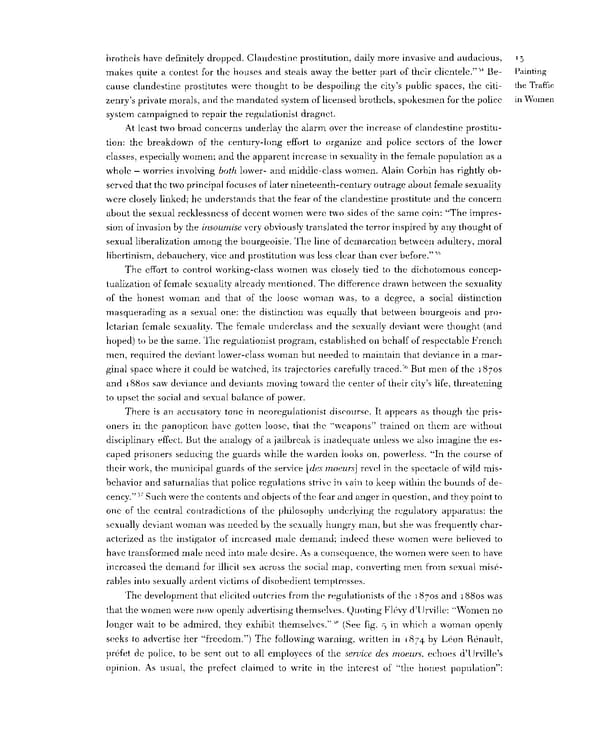brothels have definitely dropped. Clandestine prostitution, daily more invasive and audacious, !3 34 Painting makes quite a contest for the houses and steals away the better part of their clientele." Be- cause clandestine prostitutes were thought to be despoiling the city's public spaces, the citi- the Traffic zenry's private morals, and the mandated system of licensed brothels, spokesmen for the police in Women system campaigned to repair the regulationist dragnet. At least two broad concerns underlay the alarm over the increase of clandestine prostitu- tion: the breakdown of the century-long effort to organize and police sectors of the lower classes, especially women; and the apparent increase in sexuality in the female population as a whole — worries involving both lower- and middle-class women. Alain Corbin has rightly ob- served that the two principal focuses of later nineteenth-century outrage about female sexuality were closely linked; he understands that the fear of the clandestine prostitute and the concern about the sexual recklessness of decent women were two sides of the same coin: "The impres- sion of invasion by the insoumise very obviously translated the terror inspired by any thought of sexual liberalization among the bourgeoisie. The line of demarcation between adultery, moral libertinism, debauchery, vice and prostitution was less clear than ever before."55 The effort to control working-class women was closely tied to the dichotomous concep- tualization of female sexuality already mentioned. The difference drawn between the sexuality of the honest woman and that of the loose woman was, to a degree, a social distinction masquerading as a sexual one: the distinction was equally that between bourgeois and pro- letarian female sexuality. The female underclass and the sexually deviant were thought (and hoped) to be the same. The regulationist program, established on behalf of respectable French men, required the deviant lower-class woman but needed to maintain that deviance in a mar- ginal space where it could be watched, its trajectories carefully traced.56 But men of the 18705 and i88os saw deviance and deviants moving toward the center of their city's life, threatening to upset the social and sexual balance of power. There is an accusatory tone in neoregulationist discourse. It appears as though the pris- oners in the panopticon have gotten loose, that the "weapons" trained on them are without disciplinary effect. But the analogy of a jailbreak is inadequate unless we also imagine the es- caped prisoners seducing the guards while the warden looks on, powerless. "In the course of their work, the municipal guards of the service [des moeurs] revel in the spectacle of wild mis- behavior and saturnalias that police regulations strive in vain to keep within the bounds of de- 57 cency." Such were the contents and objects of the fear and anger in question, and they point to one of the central contradictions of the philosophy underlying the regulatory apparatus: the sexually deviant woman was needed by the sexually hungry man, but she was frequently char- acterized as the instigator of increased male demand; indeed these women were believed to have transformed male need into male desire. As a consequence, the women were seen to have increased the demand for illicit sex across the social map, converting men from sexual mise- rables into sexually ardent victims of disobedient temptresses. The development that elicited outcries from the regulationists of the 18708 and i88os was that the women were now openly advertising themselves. Quoting Flevy d'Urville: "Women no 58 longer wait to be admired, they exhibit themselves." (See fig. 5 in which a woman openly seeks to advertise her "freedom.") The following warning, written in 1874 by Leon Renault, prefet de police, to be sent out to all employees of the service des moeurs, echoes d'Urville's opinion. As usual, the prefect claimed to write in the interest of "the honest population":
 Prostitution & Impressionists Page 33 Page 35
Prostitution & Impressionists Page 33 Page 35